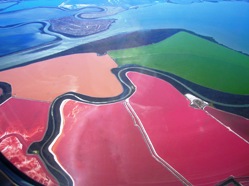 Image: Modern Haloarchaea live in hypersaline lakes, as here in San Francisco Bay. Their cells contain carotenoid pigments, presumably for UV protection, which explain the rich colours they may display when in large concentrations).
Image: Modern Haloarchaea live in hypersaline lakes, as here in San Francisco Bay. Their cells contain carotenoid pigments, presumably for UV protection, which explain the rich colours they may display when in large concentrations).
Scientists claim to have revived 250 million year old bacteria preserved in salt.
Geoscientist 21.07 August 2011
A controversy sparked in 1999
1 has been re-opened by an article by Loewenstein
2. Vreeland and Rosenweig
1 claimed to have revived by culture bacteria trapped in salt cystals 250 million years old, from the Permian Salado Formation near Carlsbad, New Mexico. Two years later Fish and colleagues at Leicester University claimed to have extracted DNA from haloarchaea even older, up to 425 million years old.
The objections to these research findings were based on the likelihood of contamination and the fact that the salt was not primary. Further researches reported by Loewenstein
2, based on salt extracted from 93 metres below the surface in 10,000 to 100,000 year-old saline deposits in Death Valley (California), have revealed 20 genera of Haloarchaea + few bacteria and
Dunialella, an algal eukaryote, in huge quantities (>10,000
Dunialella and 100 million smaller prokaryotes can live in one millilitre of water!) within fluid inclusions. Culturing can with extreme difficulty revive less than 1% of samples tested – but five microbes were apparently brought back to life.
Bacterial cells deprived of nutrients get smaller, tiny and spherical, unlike at the surface, but apparently derived their nutrients from
Dunialella – it is claimed that glycerol from one cell of the eukaryote could supply enough carbon to repair macromolecular damage for one miniaturised Archaea cell for 12 million years. Lowenstein is admirably cautious and believes much further research is needed about these processes, but he believes that fluid inclusions in salt may yet prove to be a ‘magnificent time capsule’, and that these researches obviously have a bearing on the possibility of finding traces of past primitive life in Martian surface brines.
References
- Vreeland, R.H., Rosenzweig, W.D. et al. Characterization of a 250-million year old halotolerant strain of Bacillus pantothenticus and an extreme halophile utilising two and threee carbon compounds as sources. Meeting of the American Society for Microbiology at Chicago.
- Lowenstein, T. 2011.Bacteria back from the brink. Thousand and million year old microbes found living in salt crystals. Could they exist on other planets. Earth. 56(4), 36-45.